The stories behind the most powerful photos of the battle for Mosul
"Of all the wars I have covered in various countries, Mosul has been the worst."
The offensive to recapture the city of Mosul from Isis militants began in October 2016 and went on for nine gruelling months. Photojournalists accompanied the Iraqi-led forces every step of the way, capturing the action and its awful human consequences. Several Reuters photographers tell the stories behind some of the most powerful pictures of the battle for Mosul.
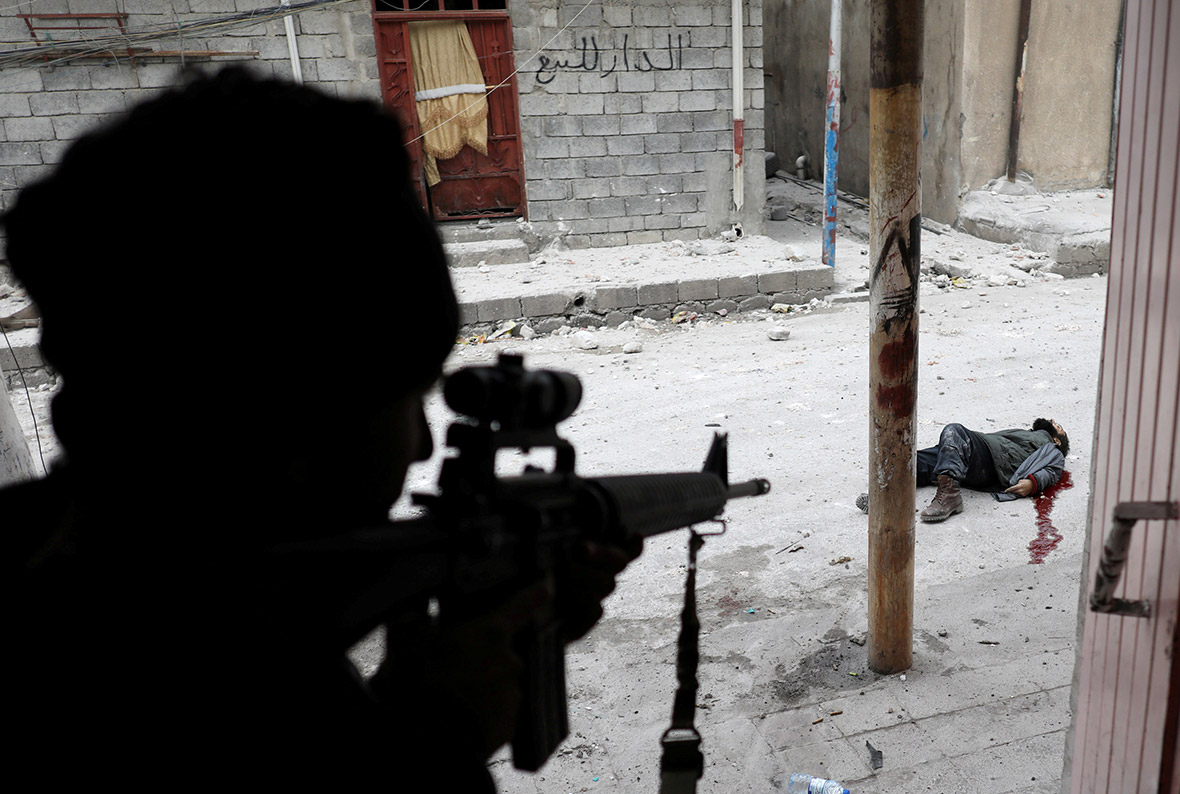




21 October 2016: Children wait to receive food supplies at a centre for displaced people in Qayyara, south of Mosul. Zohra Bensemra: "The Iraqi army was on an offensive to reclaim territory around Mosul and the fighting forced thousands to flee their homes. We went to a refugee centre at a school in Qayyara, south of Mosul and found hundreds of families who had fled Islamic State milling about chaotically outside the building. There wasn't enough humanitarian aid for everyone and refugees were desperately jostling to grab aid packets being handed out while soldiers tried to calm the crowd.
"I like this picture because you can see how exhausted the little girl is. As I took the photo, I thought this girl should be in school instead of queueing for food. She managed to escape Isis, but what does the future hold for her?"

26 October 2016: A man accused of being an Isis fighter sits in front of newly-displaced men near a checkpoint in Qayyara. Goran Tomasevic:"I was covering the early days of the Iraqi army offensive to retake Mosul from Isis when I received a tip that Iraqi soldiers were trying to stop militants escaping by hiding themselves among fleeing civilians. I reached an area close to an army checkpoint in Qayyara, just east of Mosul where scores of men, women and children were sitting together in the desert sand, watched over by soldiers, awaiting transfer to buses and trucks bound for refugee camps.
"I noticed soldiers separating one man out from the group and starting to interrogate him. It was clear they suspected he was a militant but I couldn't find out more as there were no English speakers around. I tried to reel off some quick pictures at close range. But the soldiers got upset, blocking my camera and ordering me to leave the scene. I quickly retreated for my own safety but lingered inconspicuously nearby.
"About 10 minutes went by during which the man was pushed into a shallow pit dug into the desert to hold prisoners near the refugee group. By that point, I had circled quietly around to the opposite side of the pit and snapped the picture when the soldiers were not paying attention to me. I don't know what happened to the militant as I had to leave soon afterwards to cover developments in the fighting."
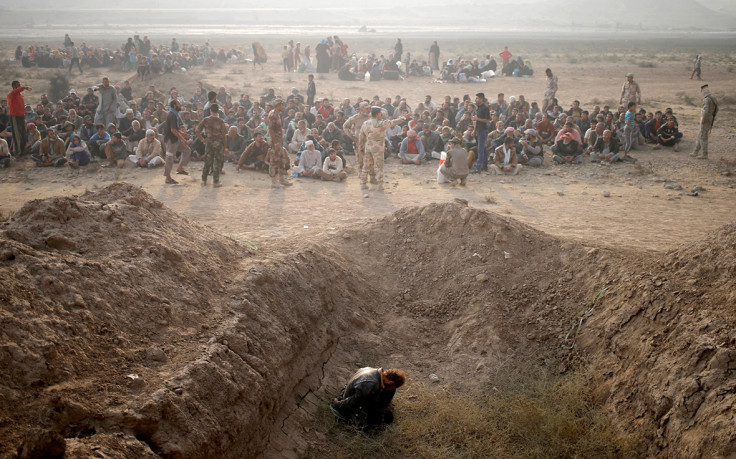
17 November 2016: People run in panic after a coalition air strike hit Isis fighters' positions. Goran Tomasevic: "I had been to the Tahrir district of eastern Mosul several times while covering the campaign by Iraqi forces backed by US-led air strikes to retake the city from Isis militants.
"Covering battles is tough and in this case, it was difficult to get to the frontline at times, but on this day we managed. When we arrived it seemed calm and quiet. Soon after a car blew up in a suicide bombing in an Isis counter-attack to the forces' push into Mosul. There were casualties, children screaming, and several nearby houses were destroyed. There were also clashes. I have covered many conflicts in my career, but what has struck me in Mosul is the number of car bombings.
"The fighting comes in waves and when things eventually quietened down, I saw a group of civilians making the most of a break in gunfire to come out onto the streets. They were both young and elderly, and felt safe enough to leave their homes with few belongings, walking carefully but calmly towards where I was standing capturing the scenes around me. Suddenly an air strike targeted Isis positions a few hundred metres away behind them. It was close and total panic ensued. People were screaming, ducking and running away as the plumes of smoke rose nearby. They quickly ran for whatever shelter they could find.
"I heard the plane just before the air strike, and from experience knew I had little time. These things happen fast and you have to act quickly. First you have to make sure you are safe, then stay focused so you can get the shot. You get your lens ready and stay calm. It was one air strike and residents waited it out before finding other shelter. I eventually moved to another location to continue covering the fighting."

26 February 2017: Iraqi Special Operations Forces arrest a person suspected of being an Isis militant in western Mosul. Alaa Al-Marjani: "I spotted four suspected Isis militants picked out of a group of displaced people by Iraqi soldiers. The suspects had been identified by civilians working with the security forces and wearing masks to protect themselves from possible reprisal by Isis. The suspects including the man in this picture were then tossed into the bed of a pickup truck. My picture was significant for our story because it helped illustrate how some militants had secreted themselves among fleeing civilians in hopes of evading capture. Some of them trimmed their bushy beards and changed their clothes in efforts to blend in.
"I had been covering developments on another front when I saw on social media that a large group of refugees was heading to this location. Not much was happening where I was so I changed cars and headed to the refugee gathering point. The way the suspects were being treated was abnormal so I felt it was very important to document this in pictures. After I took this picture, a military intelligence officer tried to seize my camera and send me away. I was working together with a Reuters correspondent and security adviser, so the officer eventually desisted and allowed me to take further photos.
"It can be difficult controlling your feelings when taking pictures right at the scene of gunfire and explosions. There is a lot of human suffering, but also a lot of competition with other agencies to get the best photograph in the shortest period of time. My camera is very modern but internet access needed to file our pictures is difficult because most communications towers in the region are down."

27 February 2017: Displaced Iraqi women who fled their home rest in the desert as they wait to be transported to safety. Zohra Bensemra: "I took this picture in a desert on the outskirts of Western Mosul of 90-year-old Khatla Ali Abdallah after she fled the battle for Mosul. Her fearful eyes red with fatigue, Khatla was so exhausted she could not stand or even sit properly. She looked to me like she had not eaten or drank water for a long time. The moment was so emotional that I had tears in my eyes when I photographed Khatla. I felt bad because I could not do anything for her apart from taking pictures to show the world the agony and torment of people trying to flee Mosul to safety.
"I was sad too, imagining this woman as my own grandmother and feeling helpless to make her comfortable. When you face such a moment, you always think that it could happen to anyone of us. But despite all, Khatla looked beautiful to me, almost as if every wrinkle on her face told a story.
"I was fortunate to find her a few days later in a refugee camp after showing people my photograph of her. She has survived decades of turbulence in northern Iraq. She told me "the fighting there is the worst I have ever seen". She had been carried across the desert by her grandsons, under sniper and mortar fire, one of thousands who braved the difficult and dangerous journey out of Isis's shrinking stronghold in western Mosul.
"Khatla made me smile when she expressed her remorse about her 20 chickens she had to leave behind. She had looked after them even while hiding from crossfire in her house's basement. Despite all the terror she experienced under IS rule, it had not destroyed her humanity. She said, 'Even animals deserve life.'"

3 March 2017: An Iraqi special forces soldier shoots dead a would-be Isis suicide bomber in Mosul. Goran Tomasevic: "I shot this picture while accompanying an Iraqi counter-terrorism military unit on a probe into an inner-city district of western Mosul held by Isis. I had spent some time "embedded" with the counter-terrorism force so they were relaxed in my presence and allowed me to follow every step of their advance.
"On this particular day we were moving slowly on foot through narrow side streets, with soldiers searching house-to-house to gradually clear the way forward. Turning a corner into a more exposed main street, we suddenly came under heavy fire from Isis, which forced us to race inside a nearby house for cover. In so doing, a soldier near me was fatally shot in the back, while once inside the house another was shot in the head by a sniper as I was speaking with him. We were in a very dangerous situation, pinned down by Isis fire, though the militants were kept back for the time being by air strikes called in by the unit commander, plus intensified mortar fire from our side. Hours passed by and daylight faded to night.
"Suddenly soldiers near me began shouting, shooting broke out and I saw one soldier shooting a would-be Isis suicide bomber trying to approach the house door. I took the picture seconds later standing just behind the shooter in silhouette, with the suicide bomber visible through a shell hole in the house wall, dead on the ground in a spreading pool of blood. It was pretty heavy stuff, extremely close-range war fighting. But I have covered the front lines of many wars so I just stay calm in these tough spots and think only how I can shoot the best pictures while seizing the right moment to pull back out of harm's way.
"This time, we had to wait until just after dawn the next day to retreat, darting from one street corner to the next to reach safety back behind the front lines."
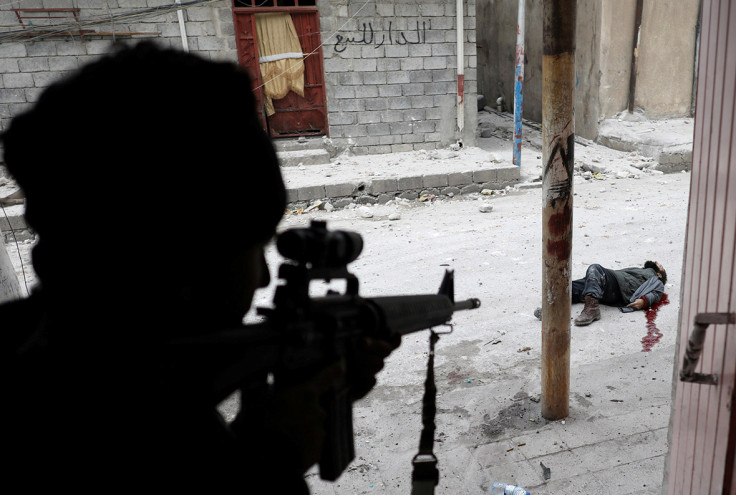
4 March 2017: A man cries as he carries his daughter from an Isis-controlled part of Mosul towards Iraqi special forces. Goran Tomasevic: "Both screaming in terror, the father and the young daughter he cradled in his arm fled through the rubble-strewn streets of Wadi Hajar, transformed in a flash into a battleground between Isis fighters and Iraqi special forces. They and their neighbours – some wearing rubber sandals, some barefoot – were running from an IS counter-attack in this part of Mosul, dodging gunfire as the militants closed in.
"When they reached the special forces lines, males were ordered to lift their shirts to prove they weren't suicide bombers. It's become a common tactic for the militants to use suicide bombers, and the soldiers were firing their guns in the air to try to slow the residents down, shouting at them in Arabic. The father was so beside himself, so panicked. It was obvious because he had a short shirt on and was carrying a child that he wasn't Isis. I believe they will both be taken to a refugee camp."
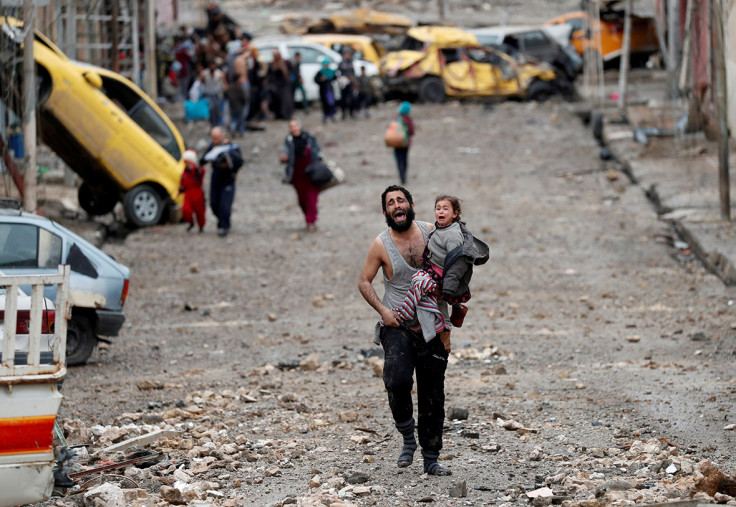
10 March 2017: A displaced Iraqi man who fled his home has his beard shaved outside Hamam al-Alil camp, south of Mosul. Suhaib Salem: "The significance of my picture stems from the fact that after Islamic State captured Mosul in June 2014, it forced all local men to grow long thick beards. So after fleeing across front lines and arriving at the Hamam al-Alil camp run by Iraqi troops, many male refugees queued up for the opportunity to be shorn.
"I was walking around the camp all day looking for good pictures when I noticed men having their beards shaved off. I ran up and snapped the old man being shaved, though he and others at first refused to let me take pictures as they were still afraid of reprisal if battlefield fortunes shifted and the militants regained control of the area. They were eventually happy and gave me permission to take pictures.
"I faced challenges every day of my Mosul assignment. Road journeys were long and arduous, with mortar bombs crashing around us frequently and the stench of bodies rotting in the streets where we walked. I have covered wars for Reuters for 19 years and this is the most dangerous one yet."
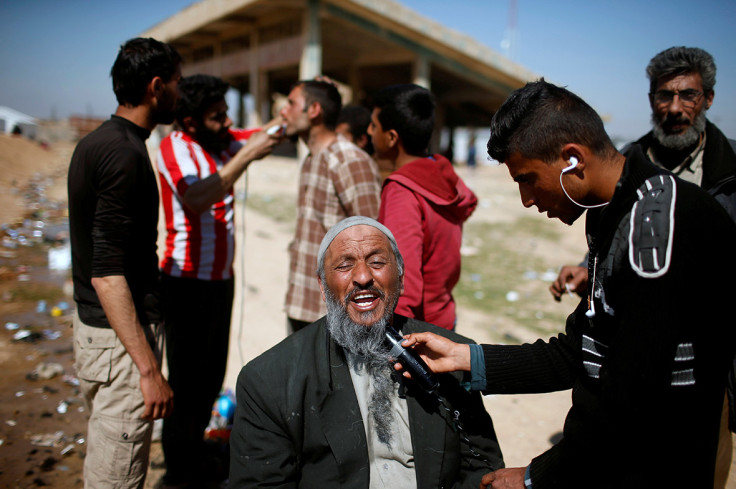
11 March 2017: Iraqi rapid response members fire a missile towards Isis militants during a battle in Mosul. Thaier Al-Sudani: "This attack came in the middle of a battle when Iraqi forces were trying to recapture the regional government compound from Isis. I was taking pictures of clashes at Mosul's antiquities museum when we spotted an Isis drone in the air above us. We dropped to the ground for fear of being attacked by a rocket.
"I cut my hand and we returned to the car to treat it. When we got there, I saw Iraqi forces firing rockets nearby at an Isis target beyond our field of vision, so I resumed taking photographs. I thought this photo was a strong one that expressed the terrible violence of battle. It is another world covering wars compared with news conferences. There is 100 percent danger, and the internet we need to transmit pictures is poor or non-existent."

10 April 2017: People walk in front of the remains of the University of Mosul. Marko Djurica: "On 10 April, a Reuters team entered eastern Mosul to work on a story about the the city's destroyed university, once a centre for education in northern Iraq. On arrival, I was struck first by the huge size of the campus, then by the scale of destruction. At least 10 large buildings and some smaller ones had been more or less reduced to rubble.
"The entrance was guarded by Iraqi soldiers, cleaning their guns and drinking tea. I saw people trying to carry furniture and equipment out from what was once the chemistry department in a burnt-out building. It turned out these men were professors who had taught there and had now volunteered to save whatever could be salvaged. As I walked around taking pictures I met more teachers trying to clean up or just gloomily contemplating the devastation. It was emotional for them as they knew there was no chance the university would be the same again anytime soon."
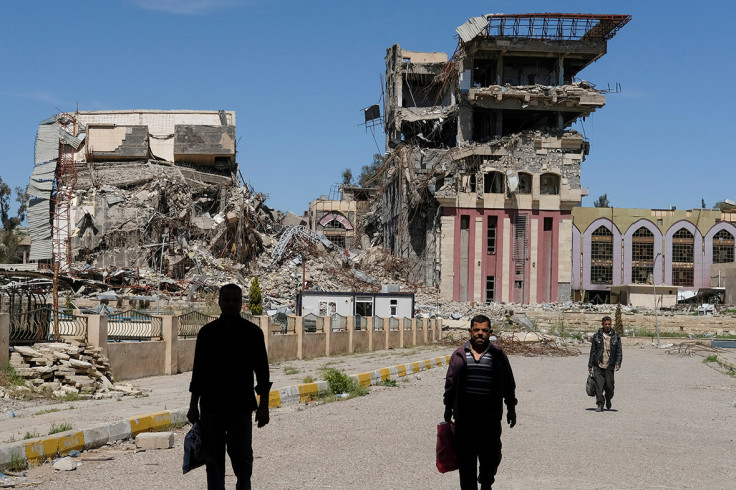
15 May 2017: Members of Iraqi Counter Terrorism Service (CTS) forces look at Isis positions during clashes in western Mosul. Danish Siddiqui: "In May, I was accompanying a senior commander of CTS, an elite Iraqi security force trained by the US, during the battle to take control of Western Mosul. We arrived at a small house on the frontline after walking through holes in the walls between homes. Isis snipers were firing a few hundred meters away.
"The people who once lived there departed quickly, leaving clothes and toys scattered across the floor. The next inhabitants left hollow shell casings. The CTS had taken over the house a day ago. The curtain was a bed sheet. They stood behind it to identify enemy snipers and watch one of their own. It's a quiet picture that tells of even the most uneventful of moments on the front, when nothing may happen, and everything is possible."
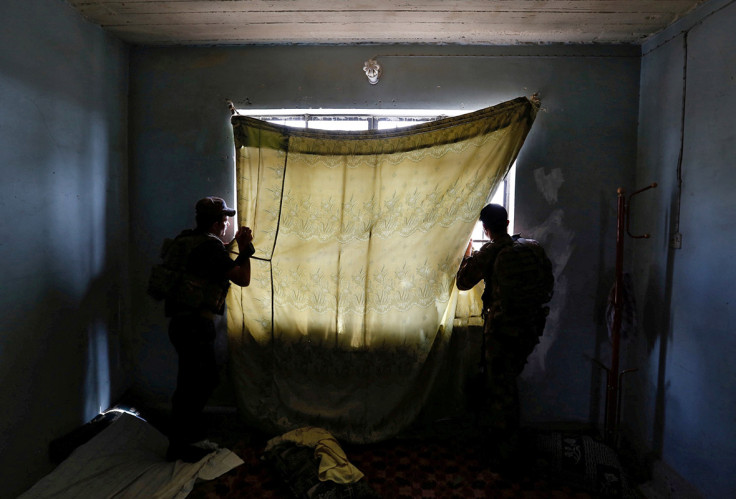
29 May 2017: A view of a part of western Mosul. Alkis Konstantinidis: "It was the second day of my assignment in Mosul and we were driving to join the Iraqi Federal Police forces at their frontline positions. The closer we got to our destination, the more obvious was the impact of the constant warfare. The cityscape was apocalyptic: demolished buildings, burnt cars tipped onto their sides, twisted masses of steel. We reached the frontline on what seemed a quiet day. But even if things appear calm, you have to be on alert about your surroundings.
"While moving fast from position to position, taking cover behind debris, I noticed a yellow car lying destroyed in the middle of the road ahead of us. I took a few wide-angle shots, which worked best as I was able to get the perspective of the street and the sweeping scale of the destruction. Not a single element of my frame was untouched by the battle.
"Later that day, I tried to imagine what this street – whose name I couldn't find out as no signs were left standing – would have looked like on a "normal" day some years ago. It appeared to be a market street; people would have crossed it in a hurry, darting between traffic. The mosque in the background would have called the faithful to prayer and it would have been full of different noises: car honks, shop-owners shouting to attract customers, music playing in coffee shops full of people. These everyday sounds had now been replaced by the heavy crump of mortars, artillery, helicopters and the clatter of gun battles. And the memory of a normal day seemed so distant."
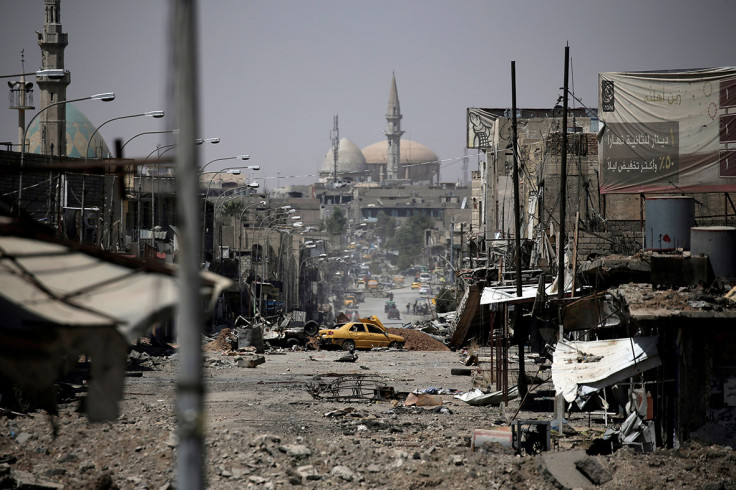
28 June 2017: A member of the Iraqi Federal police rests at the frontline in the Old City of Mosul. Ahmed Jadallah: "I left Erbil early in the morning bound for Mosul with our multimedia team and security adviser in an armoured car. After an almost three-hour drive, passing many Kurdish Peshmerga and Iraqi military checkpoints, we crossed the Tigris river and reached the headquarters of the Iraqi federal police in western Mosul. An hour later a federal police convoy escorted us to the frontline in the Old City.
"While covering a battle between Federal Police and Isis, I passed the soldier in the photograph. He was taking a rest in a temporarily more sheltered spot and draped himself with a net to keep away clouds of insects that had been attracted by dead bodies and raw sewage nearby. The picture shows the rough conditions of the frontline where there is no decent place to sleep while the fighting carries on. Just one mistake of walking down a street in the wrong direction could have landed me in the deadly hands of Isis. The most important thing is to stay out of sight of Isis snipers and drones.
"Of all the wars I have covered in various countries, Mosul has been the worst."
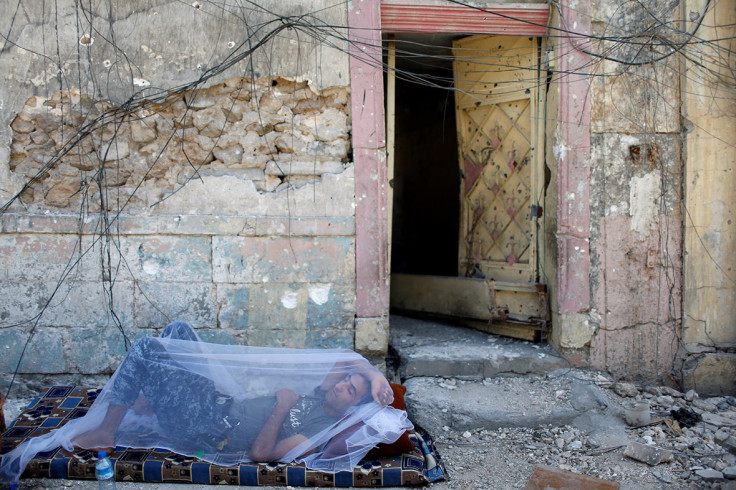
8 July 2017: Iraqi Federal police celebrate in the Old City of Mosul. Ahmed Saad: "This is the first moment of Iraqi soldiers expressing their joy and relief at the end of a brutal, nearly nine-month-long battle in which they lost many of their comrades. I went to see the celebrations when we heard that combat operations had virtually ended and the announcement of final victory in Mosul was about to be made. The soldiers were shooting in the air. Photographers were worried about being hit by falling bullets so stayed in our body armour. But I was happy that we were about to rid this part of the country of Isis and citizens could finally return to their homes.
"Wearing bullet-proof vests and helmets in the searing mid-summer Iraqi heat is physically difficult but it's important to keep safety in mind. It's also difficult to communicate with the commanders to know what's happening. And the travel across rough, rocky desert to reach frontlines is also uncomfortable and there is a lot of waiting. The internet is also bad so it is frequently a struggle to file our pictures to the world in real time. All the same, I enjoy photographing military clashes because the pictures are powerful and expressive."

Iraqi forces are continuing to clash with Isis militants holding out in Mosul's Old City, several days after Baghdad declared victory over the jihadists. Pockets of Mosul remain insecure and the city has been heavily damaged by nearly nine months of gruelling urban combat. About 900,000 people fled the fighting, with more than a third sheltered in camps outside Iraq's second largest city and the rest living with family and friends in other neighbourhoods.
© Copyright IBTimes 2025. All rights reserved.






















